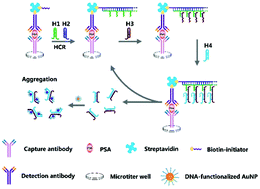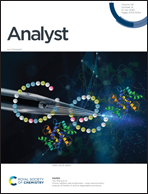DNA-Programmed plasmonic ELISA for the ultrasensitive detection of protein biomarkers†
Abstract
We report a novel DNA-programmed plasmonic enzyme-linked immunosorbent assay (ELISA) for the ultrasensitive detection of protein biomarkers with the naked eye. The DNA-programmed plasmonic assay was based on two enzyme-free and isothermal nucleic acid amplification methods: hybridization chain reaction (HCR) and catalyzed hairpin assembly (CHA). In this study, a biotin-labeled DNA probe was utilized insteand of an enzyme-label probe in well-developed ELISA method. The biotin-labeled DNA probe was able to trigger the HCR and CHA processes, and the products could hybridize with DNA-modified gold nanoparticles (AuNPs) to induce the aggregation of the AuNPs and a color change in the solution. The developed method was able to detect as low as 1 pg mL−1 PSA target with the naked eye. Clinical serum samples demonstrated satisfactory results, indicating that the method is useful for early diagnostics and monitoring curative effects after a medical treatment. The developed method presents a simple and portable platform for ultrasensitive protein detection and has potential for point-of-care (POC) diagnostics in less developed areas.



 Please wait while we load your content...
Please wait while we load your content...